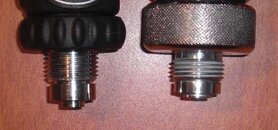Yes, it has (been beaten to death). And there isn't necessarily anything 'recent' because it is not a dynamic issue. The facts are the facts.I am sure this has been beaten to death in the past, but I couldn't find anything recent so I figured I would ask.
In the Western hemisphere, most rental cylinders will be yoke. In Europe, most will be DIN. In SE Asia, who knows? While you can hope that - in your travels in the Western Hemisphere - you will find a charter op that offers cylinders which all feature convertible valves, I would suggest that hope is not a strategy.
The most efficient approach is to buy a yoke regulator first stage for which you can also obtain a kit that allows easy - QUICK and SIMPLE - conversion to DIN - or vice versa. It is not rocket science or neurosurgery to make the conversion. You essentially remove the yoke bolt and 'A' clamp', and replace it with a DIN bolt, to convert from yoke to DIN. It takes 30 seconds, maybe 60.
An adapter - recommended by several respondents - is fine. but many people find that use of an adapter moves the DIN first stage so close to the back of their head that it regularly bumps their head when they look 'up'. I have a number of adapters, and seldom use them for that very reason.
My first reg (bought 12 years ago and still in use) was a DIN. All of my 23 first stage regs, except for three, are DIN. I convert my first stage(s) - from DIN to yoke - when I travel, without difficulty.
As for the Hollis reg, I have no comment, EXCEPT - can it be easily converted, from yoke to DIN to yoke? If so, go for it, if that is what you want for whatever reason.




